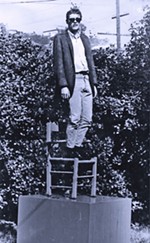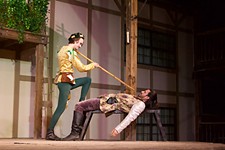Exhibitionism
Salome: Under the Veils, No Heart
Fri., May 21, 1999
Through May 22
Running time: 1 hr, 15 min.
The summer wind thick and crackling with electricity, the sky grumbling with oncoming storms, last Saturday night seemed the perfect time to see this tale of murder and seduction on the outdoor stage at The Vortex. Directed by Le Easter, who also plays the title character, Salome is the tale of a tempestuous young princess fascinated and aroused by the imprisoned John the Baptist. When the prophet refuses Salome's sexual overtures, the spoiled temptress devises a plan to get her man no matter what. She performs for her stepfather King Herod the erotic dance of the seven veils, in which the drop of each veil reveals more and more young, toothsome flesh, until the king, in the grips of his passion, finally consents to behead the prophet.
This 1894 play by wit and dramatic luminary Oscar Wilde (scribe of ribald comedies such as The Importance of Being Earnest) is a bit of a literary oddity, broad comedy written in verse, witty satire culled from Biblical legend. Kairos!, a group of Southwest Texas alumni, are certainly surefooted in the play's comic strokes, with a fey, hedonistic Richard Hinojosa turning in a king fit for Mel Brooks, and Otis Russell and Troy Davis as two bumbling soldiers who seem yanked out of a Monty Python sketch. Easter's dance of the seven veils is quite a number as well, beguiling and seductive, but also majestic to watch, as scantily clad belly dancers litter the stage with vivid fabric and glitter, sparkling unexpectedly in the light. But in between its bright spots, the show sags, seeming longer than its relatively brief running time. And while the ending -- one of those wonderfully memorable creep-outs -- somewhat makes up for it, the show seems, like Salome herself, curiously lacking a heart. It's too goofy to be taken seriously, too serious to be truly funny. And its beauty, though plentious, is only skin deep. --Sarah Hepola
BOYS' LIFE: FEAR AND SELF-LOATHING
Movements Gallery,
Through May 21
Running time: 1 hr, 45 min
Howard Korder's comic descent into the lives of three soul-sick college buddies comes to the stage in a promising production by One Theatre Company. Reminiscent of other men-behaving-badly classics (David Mamet's Sexual Perversity in Chicago, David Rabe's Hurlyburly), Boys' Life -- referring to the wholesome Boy Scouts magazine of the same name -- is an intentionally ironic title; these men steep their lives in booze, drugs, misogyny, adultery, self-hatred, and stinging acts of violence and sexual treachery. While puppy-doggish Don and Phil, with their soliloquies about romance and maturity, might seem the play's salvation, they remain both curiously numb and hollow, men whose only guilt seems to stem from the fact that know they should feel bad for their acts of cruelty, but still can't. They are asleep with their eyes open, drifting through life without purpose or meaning. Lacking any real moral compass, they look to magnetic, hostile Jack for guidance. Married with a young son, Jack is the living, breathing face of egotism, a foul-mouthed boozer angry at the freewheeling bachelor life he threw away but too self-serving to leave the wife who supports him.
It's juicy stuff, and director Louis Wells works with the material capably. But One's Boys' Life lacks the inspired moments and spontaneity that might help it leap out of the small, dark performance area at Movements Gallery. Slow blackouts and a few cumbersome set changes sap the script's quick-witted pace, which each actor must hustle to make up for. The strength in this version, in addition to Korder's Pulitzer Prize-nominated script, lies in a quality ensemble cast. The females all perform admirably, especially Pamela Ribon, adding some much needed comic energy to the second half, but their characters are underwritten devices in Korder's world, intended to bring into clear relief the brutality of these badly fractured male psyches. Instead, it is this trio of men who linger in our memory, headed by Eric Peterson as the venemous Jack. Korder and Peterson are unafraid to let him charm us and then whip right around and slap us in the face with ugliness, so that we, like his eager best friends, never know whether to laugh or cry in his volatile presence. Jack is a troubling, unforgettable character -- the all-too-realistic core of self-hatred in these boys' lives. --Sarah Hepola
ANGELS WITHOUT HEADS: YEAH, SURE
The Off Center,
May 15
The Off Center, a performance and studio space off East Seventh Street known for taking many a chance, played host last Saturday night to a piece by a hodgepodge of local performance artists, accompanied by the band Golden Arm Trio. In the background were paintings by Faith Gay and throughout the show, over paintings and faces, there played a film-projected light show of polka dots and other shapes.
The evening began with a rousing (and incredibly competitive) game of musical chairs and concluded with the audience gathered in a hand-holding circle around Stephanie Stephens as she sang, hauntingly, "I Heard the Angel Singing." In between were performance pieces by Tiana Hux and Liz Gaines. Hux's Yes/No, which she also performed at FronteraFest, is a pleading, therapy-esque question-and-answer set in which she asks the audience questions like "Do you think I'm pretty?" and "Do you vote?" to which all good sports respond yes or no. Liz Gaines was less successful at engaging the audience as her set veered between being an aggressive monologue and a jiggling interpretive dance.
To encourage audience participation, stickers and bubbles were handed out at the entrance, leading an S.U.V. full of trouble-seeking boys stopped at a nearby stop sign to ask, "Hey, is that a rave?" In fact, it did feel less like an art event than a community-building consciousness-awareness party. The question most overheard at the exit was not the performance art standard "What did you take from that?" but "Did you have fun?" The most common reply? "Yeah, sure." --Ada Calhoun
BREATHE NORMALLY: TO EACH HER OWN STORY
B. Iden Payne Theatre, May 7
It seems everyone was confused about what they would see at Breathe Normally, Margaret Jenkins' collaboration with Olympia Dukakis. Season ticket holders showed me stubs which read Time After. Early buzz about the piece suggested that Olympia Dukakis would be in the show and that it was a duet between herself and Jenkins. Then I heard that Dukakis fell ill and could not do the piece, so they reworked it without her. Some said there would be filmed projections on the dancers and others said... and still others said... Which is a perfect way to describe the piece! It was about the fragile and fragmentary nature of memory and the interconnectedness of shared experience. Just like the audience, everyone in Breathe Normally had their own version of the story. Rumors floated, fragments were revealed, memory was tested as the Margaret Jenkins Dance Company presented a multi-dimensional production which wove dance, storytelling, and projected images into a provocative and unclassifiable piece. It was, at once, dance and theatre and performance art, with a touch of vaudeville.
The narrative thread of the piece centered around a devastating car crash in the Dukakis family history, one which wiped out much of the family, and a daredevil grandfather who, as a young man, died while jumping from a train. In development since 1997, the piece marks the group's shift from a pure repertory dance company to a project-oriented team, fusing the talents of university dance departments, the Center for Theatre Arts in Berkeley, and a professional modern dance company. The company consisted of dancers/actors ranging in age from 32 to 72, who represented different members of a family, alternately dressed in gender-specific clothing and white dress shirts and pants with suspenders. The stage contained two screens, which housed projected images of old photos, hourglasses, shoes, and clouds, and created another domain for the dancers to occupy.
The piece effectively blended serious material with comedic effects. As one dancer tried to reconstruct the occupants and seating arrangements in the doomed car, he kept correcting himself and starting over, inspiring a rousing version of musical chairs in which everyone had to fit somewhere. Transitions reminiscent of early silent films with split-second physical timing featured the movement of wooden and tin boxes and trunks until they became a sculpture irresistible to one "magician," who removed the keystone without toppling the other parts. Near the end of the piece, dancers approached a pile of dress shoes and followed the directions of a dancer shouting from behind the screen -- only they performed the opposite of what they were told to do. "Forget everything!" prompted them to pick up a shoe and "Get in the car!" prompted them to put the shoes on their heads. The final command, "Put a shoe on your head!" rendered only hilarious confusion and stillness.
The text conveyed poignant, even wrenching sentiments without sounding condescending or preachy. These pearls drifted by with accompanying images or movement interludes. When questioned, a speaker attempting to formulate a suitable equation to explain unexpected death answered honestly that he was trying to "make sense of it and the numbers are a comfort." The truth in that statement struck me as so crucial to our understanding and acceptance of death. It seemed rational that the man died because, that one time, the precise conditions did not exist in order for him to live through the jump as he had many times before. He was X years older and the train was going X miles per hour faster. We need reason to hold onto when we are faced with the unexplainable.
The movement ranged from waltzes to Greek dance to grand gesture choirs to pedestrian duets consisting of simple but powerful walking, rolling, and partnering sequences. The performers were a superb unit and only occasionally did the pacing of the piece lag because a dancing section went on too long, by which I mean that the dancing went beyond supporting the other elements of the piece and became a disconnected physical musing. The show's best moments featured the interconnectedness of the parts contributing to the impact of the whole. No judgments were made as to what was most important in the script, the dancing, or the production of the piece. Each element was necessary, each fragment a profound piece of the puzzle that is shared memory. --Dawn Davis








